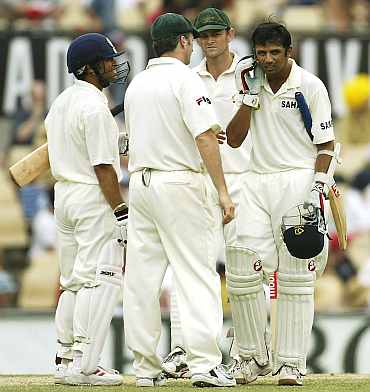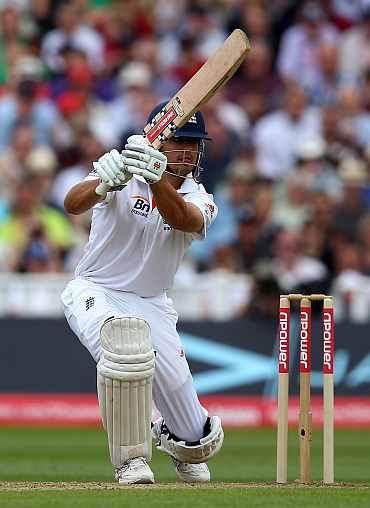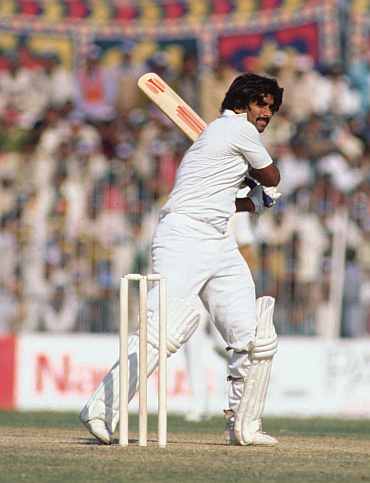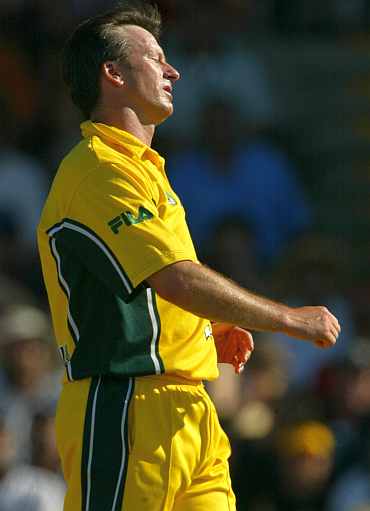
If you have a question relating to cricket and did not know who to ask, bounce them off to Rajneesh Gupta. Each week he will pick questions readers send him and provide answers. Your queries should be addressed to: Ask Rajneesh on Facebook or askrajneesh@rediffmail.com
Rajneesh's answers some questions he received from readers last week:
How many times in a Test match has a captain decided to declare the innings while a player was in his 90s, specifically on 98 or 99? Has any Indian captain done the same? - Rahul
There have been five occasions in Test cricket when a batsman was left-stranded in the nineties as the captain declared the innings.
The first such instance was at Kingston in 1953-54, when West Indies captain Jack Stollmeyer declared the innings at 209 for six against England, with Everton Weekes unbeaten on 90. This left England with a fourth innings target of 457. West Indies won the match by 140 runs.
The second instance was in an Ashes Test at Melbourne in 1970-71. Bill Lawry declared Australia's first innings at 493-9, with Rod Marsh unbeaten on 92. This would have been Marsh's maiden Test century. The match ended in a draw.
Pakistan's Imran Khan was the third batsman to miss a century due to a declaration, against Sri Lanka at Sialkot in 1991-92. Interestingly, Imran himself was captaining the side! Pakistan were in the driving seat from the start, but bad light put a spanner in their plans and Imran declared the innings on the fourth day after tea, having secured a lead of 153.
Pakistan were on the course for a win on the fifth day, but bad light again came to Sri Lanka's rescue and the match had to be called off, with Sri Lanka still 16 run behind.
England's Graeme Hick was denied a well-deserving century -- that too against archrivals Australia -- by his skipper, Mike Atherton, at Sydney in 1994-95. Trailing 2-0 in the series, England were ahead by 193 runs on the first innings and had a great chance of beating Australia.
However, they were circumspect in the second innings and batted too slowly. Atherton himself faced 166 balls for his 67. It was not until Thorpe joined Hick that they stepped up to four an over. In what was thought to be the last-but-one over of the innings, Hick, on 98, blocked three successive balls, and Atherton lost patience and declared, leaving Hick flummoxed. Although Angus Fraser caused a mid-innings collapse, Shane Warne and Tim May saved the Test match for Australia.
Rahul Dravid became the fifth and last batsman till date to be left-stranded in the nineties by his captain's declaration. However, the skipper (Sourav Ganguly) was not at fault in this particular case.
It was at Sydney in 2003-04. Batting first, India put on a mammoth 705 for 7 declared. Australia were bowled out for 474, giving India a lead of 231. Skipper Sourav Ganguly opted not to enforce the follow-on and batted instead. Virender Sehwag gave India a quick start. Dravid and Sachin Tendulkar then took over. Ganguly had to declare the innings, but he would have waited for Dravid's century before declaring. Unfortunately, Dravid was hit on the ear while attempting a hook off Lee. Seeing that Dravid was going to come off for treatment, Ganguly declared the innings. The match ended in a draw.
If a batsman gives a return catch to the bowler, and the bowler, after taking the catch, runs out the non-striker who is out of his crease, does that mean both, the batsman, can be given out -- one caught and the other run-out? Has there been any such incident in the past? - Hame Kapoor
Once a wicket has fallen, the ball becomes dead and there is no question of other batsman also falling off the same ball, even though the dismissal might have been justified in normal circumstances. In simple terms, double-play is not allowed in cricket.

Is there any instance in Test cricket when one of the players scored a century and no other player scored more than 10 runs in that innings? - N Lodha
Such an instance has not yet occurred in Test cricket. The lowest second-highest individual score in an innings where a batsman scored a century is 13 in the Centurion Test between South Africa and Sri Lanka in 1997-98.
Daryll Cullinan scored 103 in South Africa's total of 200, with Gary Kirsten and Mark Boucher scoring 13 each.
In the Sydney Test against England in 1978-79, Graham Yallop scored 121 in Australia's total of 198, with Kim Hughes, the second highest scorer, making only 16.
In the Port Elizabeth Test against South Africa in 1992-93, Kapil Dev scored 129 in Indian's total of 215, with Anil Kumble and Kiran More scoring 17 each.
However, this is not a true measure of a player's dominance in an innings. A ratio of highest score to the second highest score in the innings will give a better idea.
Charles Bannerman scored 165 (retired hurt) in Australia's total of 245 in the first ever Test at Melbourne in 1876-77. The second highest contribution was Tom Garrett's unbeaten 18. This meant Bannerman scored 9.17 times more than the second highest scorer in the innings.
Daryll Cullinan's above performance comes third in this list with a ratio of 7.92, behind Bannerman and Allan Border, whose 163 against India at Melbourne in 1985-86 was 8.15 more than the second highest scorer Ray Bright's 20.
If a bowler takes the last two wickets in two consecutive deliveries and that match is finished, and he takes the wicket on the first ball in his next match, can it be called a hat-trick? - Shailesh
A hat-trick can spread over different overs and different innings, but it has to be in the same match. In the circumstances you mentioned, it won't be considered a hat-trick.

Are there instances of a team's combined totals of both innings in a Test match being less than the individual score of the opposing team and a team's total in either of its two innings being less than the individual score of one opposing batsman? - Ranjit Roy
There are many instances of a side scoring more than the opposition's two innings. In fact, this is what happens in an innings defeat, where the winner's total in one innings is more than losing side's two innings combined. Till the end of the Sri Lanka-Australia Test, this has happened 349 times in Test cricket.
There have been 274 instances when a batsman scored more than the opponent's one innings (where all 10 wickets fell). The most recent such instance was seen at Birmingham in August this year where England's Alastair Cook's 294 was more than India's either innings (224 & 244).
In addition, there have been five instances when a batsman scored more than the opponents' two innings combined! England's Bobby Abel and Len Hutton, Australia's Don Bradman and Matthew Hayden; and Pakistan's Inzamam-ul-Haq hold this distinction.

Was Javed Miandad ever given out LBW in a home Test? How many times did he get out in this fashion overseas? - Bhanu Parmar
Javed Miandad's first leg-before-wicket dismissal in a home Test came in his 50th innings -- against Sri Lanka at Sialkot in October 1985. By that time he was dismissed LBW 15 times in 60 innings overseas.
Miandad's overall tally of LBWs in home Tests was 8 in 86 innings and 25 in 103 innings outside Pakistan.
Has any cricketer made his debut on his birthday? - Abhishek Zararia
The players to make their Test cricket debut on their birthdays are: Bransby Cooper (Australia), 'Stork' Ford, Fred Tate, Arthur Gilligan, Jack Iddon (England), Ben Sealey, Ridley Jacobs, Ricardo Powell, Sewnarine Chattergoon (WI), Dattu Phadkar and Sunil Joshi (India).
The players to make One-Day International debut on their birthdays are: Murray Bennett (Australia), Chris Lewis, Graeme Hick, Ian Salisbury (England), Bevan Congdon, Martin Snedden (New Zealand), Asif Mujtaba (Pakistan), Gursharan Singh (India), Grant Paterson, Greg Lamb (Zimbabwe), Morshed Ali Khan (Bangladesh) and Vernon Philander (South Africa).
No player has made his Twenty20 international debut on his birthday.

Which batsman got out the most number of times in the nervous 90s -- in Tests and ODIs? - Raj
Australia's Steve Waugh has 10 scores in the 90s against his name, but his tally includes two instances when he remained unbeaten.
The record of getting out in the nineties on most occasions is nine instances, shared by three batsmen -- Australia's Michael Slater and India's Rahul Dravid and Sachin Tendulkar.
India's Sachin Tendulkar got out in the nineties on 17 occasions in ODIs. No one else has even managed 10.
Please tell me the highest innings played by a batsman in his last ODI as well as in his last Test? - Abdul Mueed
Five batsmen have scored a century on their last ODI appearance. They are: England's Clive Radley, West Indies' Desmond Haynes, New Zealand's James Marshall and Netherlands' Klaas-Jan van Noortwijk and Feiko Kloppenburg. (India's Virat Kohli and the Netherlands' Ryan ten Doeschate have also scored a century in last ODI they played, but these two are still active and hence cannot be clubbed with the five others). James Marshall holds the record of playing the highest innings in his last ODI. He made 161 (off 141 balls) against Ireland at Aberdeen in 2008.
Five players have managed a score of 200 or more in their last Test match. They are: England's Andy Sandham, Australia's Bill Ponsford and Jason Gillespie, West Indies' Seymour Nurse and Sri Lanka's Aravinda de Silva (England's Ian Bell has also achieved this distinction but he is still active). Sandham had scores of 325 & 50 against West Indies at Kingston in 1929-30. Seymour Nurse's 258 against New Zealand at Christchurch in 1968-69 is the highest score by a batsman in his last Test innings.